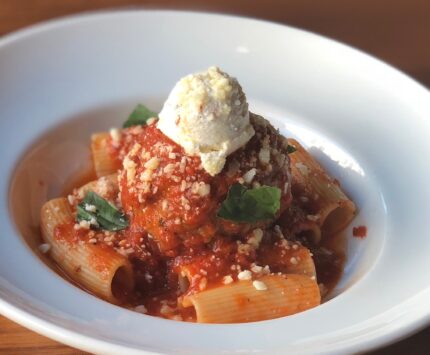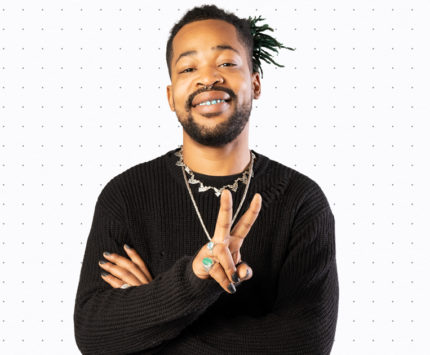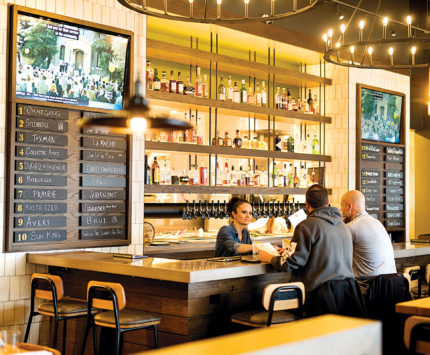Q&A With Phil Bardales Of Bardales Seafood

Phil Bardales of Bardales Seafood
HEADING OUT TO scallop or drag for fluke and sea bass were mainstays of Fort Lauderdale native Phil Bardales’s daily life as a commercial fisherman in the south Atlantic. And while fishing will always be his passion, the injuries he sustained in a boating accident have grounded Bardales, at least for now, in Broad Ripple, where he’s sourcing some of the freshest seafood and shellfish restaurants and local home chefs have ever seen in Indiana. At his eponymous Bardales Seafood on Coil Street, he’s quickly becoming the go-to resource for seafood-lovers, not just for his day-boat fresh cuts of rare yellowedge grouper and queen snapper but for his knowledge of sourcing, storing, and cooking the fruits of the sea. We recently caught up with him to get some fish stories and to clear the waters about the often confusing world of seafood.
When did you first discover your love of fishing?
I’m not really sure how it all started. I grew up in Fort Lauderdale, which has plenty of fishing resources, but my dad was an avid golfer, not a fisherman. I used to watch all of the fishing shows on ESPN, and soon enough my parents were having to drag me off of the lake or canal across the street to come in for dinner. But I had this passion, and instead of trying to get me to do something less dangerous or more profitable, my parents backed me up 100 percent. “Keep fishing,” they said, and that’s just what I did.
Yet you didn’t pursue a fishing career at first?
I figured I should get a business degree, so I enrolled at Valencia College in Orlando. As soon as I started my classes, I realized that this was not the path I wanted to take. I needed to be fishing. So I went down to Key West and nearby Fort Jefferson, where I lived on a boat for over a year. It was full of cockroaches, but I knew this is where I needed to be to get my start. One night my buddy and I were at a bar talking about fishing, when the guy sitting next to me said he was looking for a new crew member of his boat.
But this wasn’t just any boat.
No, it was the Hannah Boden, which was docked across the harbor from where I lived. That’s the boat from the The Perfect Storm. I was in awe, but the captain just said that it was another boat, and he needed help. At first he said he’d be back in 10 days, but then he asked me if I could start the next day. He could sense my passion, so he gave one of the other deckhands a $20 bill and told him to leave and hired me. That was definitely my in to the commercial fishing industry.
You moved up pretty quickly in the business?
At first we were fishing for golden crab, but they’re notoriously tough to get, and it’s expensive to fish, so we decided to fish for red crab, which is more plentiful, instead. We went to Virginia for a bit, but then we went all the way to New Bedford, Massachusetts, where I stuck with the same outfit for nearly eight years. I went from a greenhorn to a deck boss in a couple of seasons, then I was captain after my fourth year. I ran my own boat, the Sea King, for four crab seasons until I got a bigger boat called the Diamond Girl. After a family tragedy, I took some time off and went back to my happy place, Key West, to regroup.
How did you make it from the Atlantic to landlocked Indiana?
It was an accident, really, that got me here. When you’re on fishboats, you’re always in danger and hurting yourself. But I was back on a calamari boat off the coast of Virginia, on a 12-day trip. Everything was going well, but then I was unclipping a link to a net. The mate on the boat hauled the hydraulics, but I was wrapped in the cable. I heard a loud thump, and two discs popped out of my spine. I had two herniations. I recovered, but it was right before the COVID-19 pandemic started in 2020. About that time, I met my girlfriend, Tabitha, who lived in Indiana. She texted me and asked me if I wanted to come live in Indiana.
That must have been a bit of a culture shock.
I’d never lived away from the ocean, so I had no clue what I was going to do. I applied at Bass Pro Shops and Cabela’s, but when they asked me how to outfit a customer to fish in the Great Lakes and I said I didn’t know, they didn’t hire me. There was a snowstorm in early 2020, and I went searching grocery stores for fresh seafood in Indy. I couldn’t find anything that I was looking for. So I got this idea to look for a spot to bring in fresh fish, the stuff that people and chefs just haven’t seen in Indy. I found that spot right across from Rene’s Bakery on Coil Street in March of 2020. I knew it would be perfect for retail, but we had to demolish the inside and rebuild it. And then there was a six- to seven-month wait for an indoor refrigerated case. In the meanwhile, I went poking around restaurants and asking what they needed, as well as showing them some great fresh yellowtail snapper that I had. Soon enough, I landed some accounts, including Tinker Street. I was just so happy to show them what truly fresh seafood looked like.
What do most people not understand about “fresh” seafood?
For one, they don’t understand that the supply of seafood in the U.S. is just nowhere near what we can provide. We’re great about sustainability, but that means that our production gets limited at times, and then it’s hard to build it back up. About 80 to 90 percent of seafood in this country is imported. People also think that buying fish on the coasts is the only way to get fresh fish. But what they don’t realize is that often the boat has been out to sea for as much as two weeks. True day-boat fish, which I’m getting, only stays on the boat for one to two days, then there is a great network of trucks that brings it on ice to places like Chicago. It’s just as fresh or even fresher than what people can get on the coasts.
What do you tell someone who wants to get the best seafood possible?
Trust the person you’re sourcing from. No amount of looking at the eyes to make sure they’re not cloudy or examining the bloodline to see that it’s bright red can ensure that the fish was caught on a line or farmed in the open water, and so much seafood comes in frozen, is treated with carbon dioxide, and then is thawed and sold as fresh. Tuna steaks, for instance, can look very pink, but they’re usually previously frozen. If you do buy fish frozen, you should buy it IQF, or “individual quick frozen,” so you know that it’s frozen individually within hours of the catch. But none of this matters if your fishmonger can answer your questions about where the fish comes from, where it’s caught, and whether it’s fresh or not.
Have you tried lake fishing in Indiana, or does that break your heart?
I actually recently got a couple of poles for fishing crappie, and I was so proud to catch my first one in a lake. I think it’s great that people in Indiana fish in lakes, but the key is not just to let the fish die in the water on the string while you’re fishing. You need to put those fish on ice immediately, but don’t keep them on ice for more than an hour or two. I was so excited to try the crappie. I cooked it up with some grouper and snapper I had, and the people from here were just floored by what fresh Caribbean fish tasted like. But I was saying how great the crappie was.





